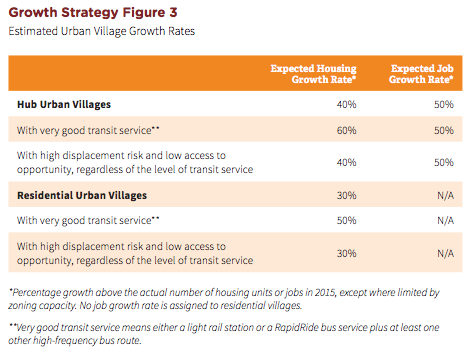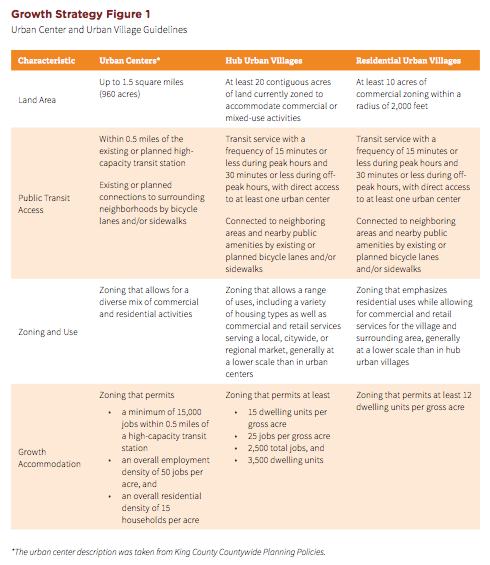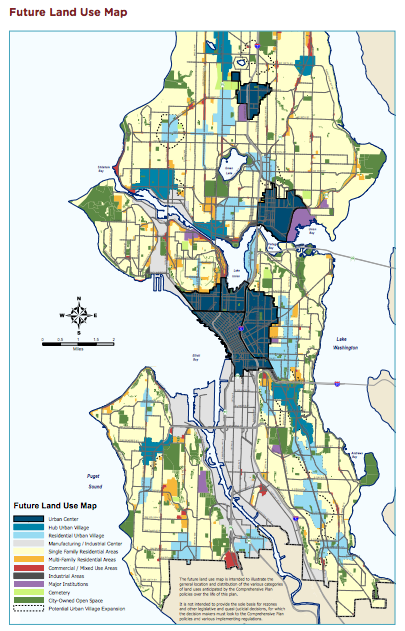This City Council will begin deliberations today on amendments to Seattle 2035, the City’s major update to the Comprehensive Plan. As of August 10th, Council Central Staff had compiled 159 possible amendments to the Mayor’s Recommended Plan. The lion’s share of the proposed amendments are simply technical amendments–changes that don’t substantively alter policy, but instead provide minor corrections and clarity to the plan. Only 13 sets of amendment proposals would actually make major substantive policy changes to the plan. Councilmembers could raise additional amendment proposals during the Planning, Land Use, and Zoning Committee discussion on the plan.
The following is a summary of the proposed substantive policy changes:
Community Involvement Element
- Community Involvement Element. One amendment proposal is to establish a new “Community Involvement” Element which would transpose some goals and policies from the Growth Strategy Element. Other policies could be added to the Element to outline the City’s approaches to community engagement. An option that the Council could evaluate is the merging of the Neighborhood Planning Element into a “Community Engagement Element” instead.
Growth Strategy Element

- Amend urban village growth rates. Figure 3 from the Growth Strategy Element outlines the anticipated growth rates of housing and employment in urban villages depending upon certain characteristics. Two amendment proposals could adjust the growth rates. The first amendment proposal would increase future growth estimates for areas recognized as having High Access to Opportunity and Low Risk of Displacement. The second proposal would decrease future growth estimates for areas recognized as having High Access to Opportunity and High Risk of Displacement.
- Growth along transit corridors. The Seattle Planning Commission recommended that a new policy be adopted to support residential and commercial development along transit corridors. The specific policy reads as follows: “Allow for some residential growth along transit corridors to support broader access via frequent, reliable transit to the essential components of livability provided in urban villages and urban centers.” To support the policy, additional discussion for development in areas outside of urban villages and urban centers would be added.
Land Use Element

- Scale and density. The Recommended Plan vaguely identifies the scale and density of development allowed in urban villages and urban centers. For example, LU 1.3 states: “In urban centers, a moderate to high-density and scale of development; [i]n hub urban villages, a moderate density and scale of development; [and] [i]n residential urban villages, a low to moderate density and scale of development[.]” The vagueness of the policy, however, makes it difficult to truly understand the qualities without referring to Figure 1 in the Growth Strategy. One amendment option is to provide detail guidance on the scale of development and characteristics of urban villages and urban centers in Figure 1. Another amendment option would be to explicitly provide guidance on the envisioned scale building heights, floor area ratios, and other density measures. A third amendment option would be to spell out policies for higher allowed densities in areas near light rail stations and frequent bus service. It’s possible that a mixture of these amendment proposals could be adopted.

-
Future Land Use Map (FLUM). One proposed amendment would remove the “potential urban village expansion” areas pending refined details for where the actual expansion boundaries would go. A second proposed amendment is very technical in nature but would remove the shading of urban villages and urban centers. Another proposed amendment would adopt the current FLUM until 2017 when defined FLUM changes would be made. And a fourth amendment could add urban village expansions around potential Sound Transit 3 stations.
- Industrial lands. The July 2015 Draft Plan of Seattle 2035 contained language that would encourage protections of industrial land in the Manufacturing/Industrial Center for industrial uses and explicitly discourage commercial industrial zones. Yet, the Mayor did not recommend the policies and instead created a working group tasked with identifying the best path forward on policies and regulations for industrial lands in the city. The Mayor’s Recommended Plan adopted less clear guidance on than the Draft Plan. One amendment proposal would be to simply retain existing language from the Recommended Plan. Another amendment proposal would be to adopt the July 2015 Draft Plan language. And a third amendment proposal would be to use the existing Comprehensive Plan policy language instead of either Seattle 2035 option.
- Allowing development in proximity to urban villages and urban centers. Under the Land Use Element, policy LU 7.3 states: “Consider allowing redevelopment or infill development of single-family areas inside urban centers and villages, where new development would maintain the low height and bulk that characterize the single-family area, while allowing a wider range of housing types.” During review of the Seattle 2035 proposal, the Planning Commission encouraged more flexible language to where redevelopment or infill development of single-family areas could occur. One amendment proposal would be to allow redevelopment or infill development of single-family areas near urban villages and urban centers rather than just within them. Another amendment proposal would be to strike LU 7.3 altogether.
Transportation Element
- Frequent transit and high-capacity transit language. Language throughout the Recommended Plan is inconsistent with regards to “high capacity transit.” A variety of terms are used like “very good bus service,” “high-capacity transit station”, and “very good transit service.” The usage of multiple terms is somewhat confusing depending upon the context. A proposed amendment could simply the usage of terms to “frequent transit” and “high-capacity transit station.” Changes as a result of this policy decision would be broader than just the Transit Element as the terms are used in other Elements as well.
Housing Element
- 10-year/20-year housing goals. The Recommended Plan has a housing goal (HG2) that states: “Help meet current and projected regional housing needs of all economic and demographic groups by increasing Seattle’s housing supply. Strive to add or preserve fifty thousand housing units by 2025, including twenty five thousand rent/income-restricted units.” A proposed amendment would strike the second sentence which explicitly outlines the 10-year housing goal. Instead, the phrasing could be replaced by similar language that is used throughout the Seattle 2035 plan that references housing and employment goals over the next 20 years (i.e., Year 2035 instead of Year 2025) and be moved the Housing Element discussion section.
Utilities Element
- Municipal broadband. The City has sought to create a municipal broadband network for a number of years now, but the Murray Administrative decided to table the issue last year. The Recommended Plan does not include any policies regarding municipal broadband, but one amendment could add language that provides a clear directive to study the potential of such a system and consider implementation.
Parks and Open Space
- Metrics and goals for parks and open space. The Recommended Plan as drafted points to the Parks Development Plan for goals on the amount and distribution of parks, recreation facilities, and open space in the city. However, the Seattle Parks Department has yet to complete the plan, which is anticipated to be adopted in 2017. A proposed amendment would retain the City’s existing goals for parks, recreation facilities, and open space until the goals are revised and adopted as part of the 2017 Parks Development Plan (PDP) or otherwise revised by amendments to the Comprehensive Plan in 2017.
Arts and Culture Element
- Historic preservation. The Land Use Element already speaks to some aspects of historic preservation, but the topic is also directly relevant to the Arts and Culture Element. A proposed amendment would result in the addition of policies that “recogniz[e] the importance of historic preservation in the creative economy and cultural space and placemaking sections of the Element.”
Neighborhood Planning Element
- Additional direction on future neighborhood planning. The Neighborhood Planning Element contains a broad policy (NP 1.1) that directs the City to “prioritize neighborhood planning in areas expecting or experiencing significant change, primarily urban centers or villages, especially those that have not equitably benefited from the city’s growth.” However, the City is in the midst of remaking what inclusive engangement and community involvement looks like. A possible amendment could provide additional guidance as to how to engage communities that are often left of out planning processes, areas that want positive change but where it is not being realized, and in areas that are underserved regardless of whether or not localized changes are occuring or anticipated to occur.
Technical Amendments
It’s worthwhile noting that the technical amendments should not simply be glossed over. While the majority of small corrections, some would genuinely add policies to the Comprehensive Plan to enhance existing policies or recognize existing actions and relationships from the City. The following is a small flavor of that:
Add a new policy
AC 4.12 AC 4.12 Recognize the importance of live music and entertainment venues to the vibrancy of the city’s culture. Support the viability of these small businesses and nonprofits in areas undergoing development through policies that proactively engage and balance the interests of music venues and new residents.
Add a policy P 1.16 regarding parks planning and community engagement:
P 1.16 Engage with community members to design and develop parks and facilities based on the specific needs and cultures of the communities the park is intended to serve.
Add a new policy ED 4.7 related to older workers:
ED 4.7 Support efforts to provide training and job placement for older workers and others who may have unique challenges finding employment.
Add a new policy CF 4.8:
CF 4.8 Seek to mitigate impacts of City projects on adjacent communities, especially lower income residents and small businesses, in order to reduce the possibility of displacement.
Add a new policy P 1.17 to the Access to Open Space section:
P 1.17 Create innovative opportunities to use existing public land, especially in the right of way, for open space and recreation, including street plazas, pavement to parks, parklets, lidding of reservoirs, and community gardens.
Dozens of additional examples are contained within the Council Central Staff memorandum and most are likely to be adopted as amendments since they generally align with the direction of Council priorities and reiterate much of the work that the City already is already doing or advocating for.
Stephen is a professional urban planner in Puget Sound with a passion for sustainable, livable, and diverse cities. He is especially interested in how policies, regulations, and programs can promote positive outcomes for communities. With stints in great cities like Bellingham and Cork, Stephen currently lives in Seattle. He primarily covers land use and transportation issues and has been with The Urbanist since 2014.


